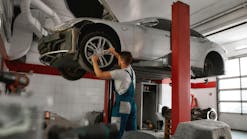Have you heard the old adage, “If you don’t write it down, it never happened”? With today’s digital society, that is even more true. Most people, especially millennials, want complete information instantly. This is even more important when it pertains to something they may not fully understand, like their vehicle. If they do not understand the information provided by you, many customers will take the opportunity to go online to obtain enough material to comprehend what you told them.
In your shop, does the need to provide more information to your customer create fear, or an opportunity? There is absolutely nothing wrong with providing a customer information, as long as it is consistent and correct.
Consistent information
Your customers expect and deserve consistent information. In order to provide it, you need to instill a culture in your shop where inspections are performed in a detailed and complete manner.
If your shop institutes and maintains a job procedure for the inspection process, each technician will inspect the vehicle in the same way and report the results consistently, thus making it the standard.
From the customer’s viewpoint, consistent information is crucial to building and maintaining trust in your shop. If on one visit a technician recommends (I prefer the term “suggests”) the struts could be replaced due to age and wear, and on the next visit the same suggestion is not made, the shop’s inspection and service suggestion/recommendation process will seem inconsistent, and the customer may question whether the first suggestion was necessary.
Having an accurate method of maintaining inspection results from one visit to another is essential for good customer communication.
Correct information
Along with consistency, correct information builds and maintains customer trust. Mistrust can occur. For example, if technician 1 performed a visual inspection of brake pad wear during a customer’s visit and reported 70 percent wear of the brakes, and technician 2 reports 50 percent wear on the next visit. What will your customer think? Who is correct?
As a matter of fact, there are two issues here:
1. You should never report brake, or any other wear item, in percentages. Unless you know exactly what the original dimensions of the new part were, you cannot accurately state what percent of wear is used or remaining.
2. It appears each technician is inspecting brakes differently. Again, it is important to have an inspection procedure in place, and train technicians to inspect and report the results accurately.
Timely results
With today’s digital-focused and busy society, timeliness of information is a critical element of communication. A number of recent surveys show that text communication between shop and customer not only expedites the approval process, but may also free up time for the service advisor.
A digital format, whether email or text, will allow you to send information to the customer quickly. It also allows you to send images, estimates, and if desired, links to additional information explaining more about the repair.
Possibly the best reason to provide to your customer is that doing so adds value to your services. In today’s shop environment, it is necessary to stand apart from your competitors. Since relatively few shops provide a digital report to their customers, doing so sets you apart.
Pre and post-inspections
As part of your inspection process, you should consider providing your customer with pre- and post-repair scan data showing the condition of the vehicle’s computer system(s) when the vehicle arrived, as well as when it is delivered. Collision shops were first led into this process at the request/mandate of most automobile insurers. They do this in order to evaluate the vehicle for any possible underlying conditions that may affect the cost of a complete repair.
This information allows the insurer and the shop to provide the customer with better information about the vehicle, before any repairs are made. Think about this for a moment and consider the benefits of providing this information to your customer. By providing a pre-scan -- including the status of the monitors -- would you be able to avoid potential comebacks? Quite possibly.
Let’s assume a vehicle has a misfire causing a check engine light to be illuminated. If the technician does not look at and record the status of monitors, they could overlook a pending code from a catalytic converter. We all know that some misfires can cause damage to a catalytic converter, but your customer probably does not understand this. If you were to advise them that based on pre-scan data there is a possibility the converter was damaged due to the engine miss, and the check engine light may come on again after you repair the misfire, you will more than likely avoid having the customer assume you did not repair the vehicle correctly.
The information from a pre- and post-scan of the vehicle should include current and pending codes and the status of the monitored systems. Monitor status can also prepare the customer for issues that arise after a monitor is able to run. For instance, many vehicles are unable to complete an EVAP test if there is a current code for a misfire. This again could cause a check engine light to illuminate shortly after you repair the vehicle.
In both cases, better communication with the customer before the repair can avoid having the customer assume you repaired their vehicle either incompletely or incorrectly.
Tools for pre- and post-scans
The tools required for pre- and post-scans are tools most technicians routinely use now. TScan tools have the capability of providing this data to the technician and service advisor; they are just a little cumbersome, unless it is a late model scan tool that has incorporated either a way to transfer the information to your shop management system (SMS), or at a minimum, a printable report.
A few recently introduced products specifically designed to create a report detailing the status of the complete OBD system. These tools allow you to provide a very easy-to-understand report to your customer that shows current and pending issues to all systems monitored by the vehicle’s onboard computer network.
The digital inspection
When you add up all the benefits of providing digital information to your customers, it is clear you need a system capable of not only recording results, but also forwarding them to your SMS, and from there to your customer.
There are now tools that will assist you in giving your customers the trifecta: correct, consistent and timely information.
As far back as 2003, I installed an electronic inspection system and process into my shop. The system was created by Delphi and showed me the value of providing reliable digital information to your customer. This system allowed each technician to have a tablet with which they performed a walk-around inspection, along with having the ability to record results of other inspected items, such as brake measurements. The system also collected scan data with current and pending fault codes as well as the status of all monitors.
The data was relayed to my SMS where I could then pass it along to the customer in a printed or digital format. The SMS was also available to refer back to each inspection on subsequent customer visits.
In reality, the system was a little bit ahead of its time and was discontinued by the supplier due to lack of interest from shops.
Vendors now have sophisticated versions of this type of technology for shops to use. The digital inspection systems all have some similarities:
- They communicate directly with most SMS databases.
- Communication between the service advisor and technicians is quicker, better and, in most cases, more efficient and productive.
- Customer communication is faster and more consistent.
- After implementing a system, sales usually improve.
Since digital inspections are an evolving technology, I would urge you to find out more about each system that is available. Some of the things to consider before purchasing a system are:
- What does the system cost?
- Does the system communicate seamlessly with your SMS?
- Is the system cloud-based or hosted on your computer?
- What developments are they currently working on and are they included in the price?
- What scan tools will communicate with the system?
- What types of hand-held devices are used with the system, Android or IOS?
I also suggest you speak to some users of each system to see what they think of it and how they implemented it into their shop.
Each of the vendors I spoke with had the same comment about implementing a system in most shops; there are users that utilize all of the features, and their sales increases are substantial. There are also some shops that just use a small amount of the available features and their sales do not increase as much as those who use all of the features, but all users will gain benefits by performing digital inspections.
I would also suggest checking with your SMS provider to see what system will work well with your management system, as well as which scan tools will allow communication from pre- and post-scans.
I am sure that each of you has an idea of what your individual customers want from you, and how you want to operate your business. Sometimes a product or a way of doing business comes along that just does not sound right for you or your customers, and you avoid implementing it. When it comes to documenting inspections and providing the results to your customers, it is quickly becoming necessary and will be the norm, rather than the exception. I would urge you to consider obtaining a system and implementing it in a way that follows your business model, while allowing you to communicate with your customers better and more efficiently than you currently are able to.
Finally, take the opportunity to attend trade shows, such as the upcoming AAPEX show in November, to see available products first-hand and to check with other vendors to find new products that are being released.



